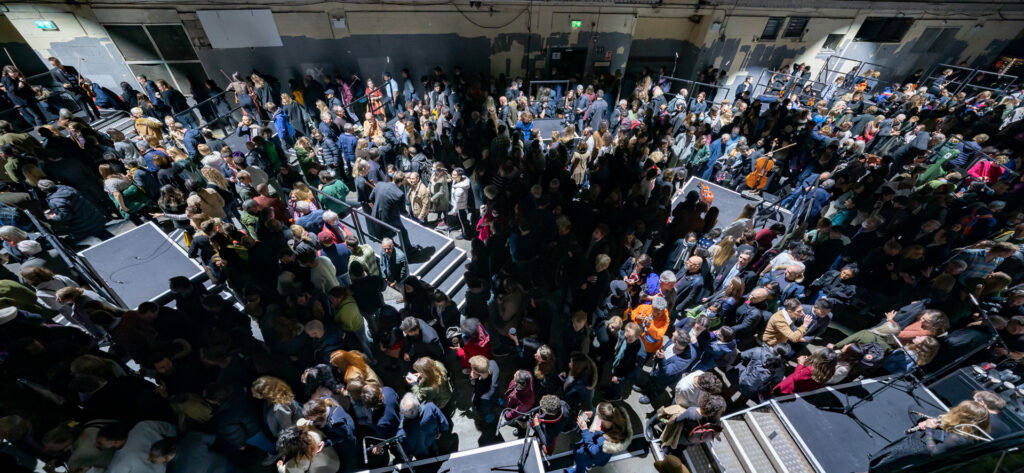Stepping Inside Beethoven
24 October 2023
How do you bring an audience of more than 1,500 people physically inside a Beethoven symphony? Over the past two years, generous support from the Royal Philharmonic Society Audience Fund has enabled us to explore some possible answers to that question. We reflect back on two thrilling experimental projects at Printworks and what we discovered…
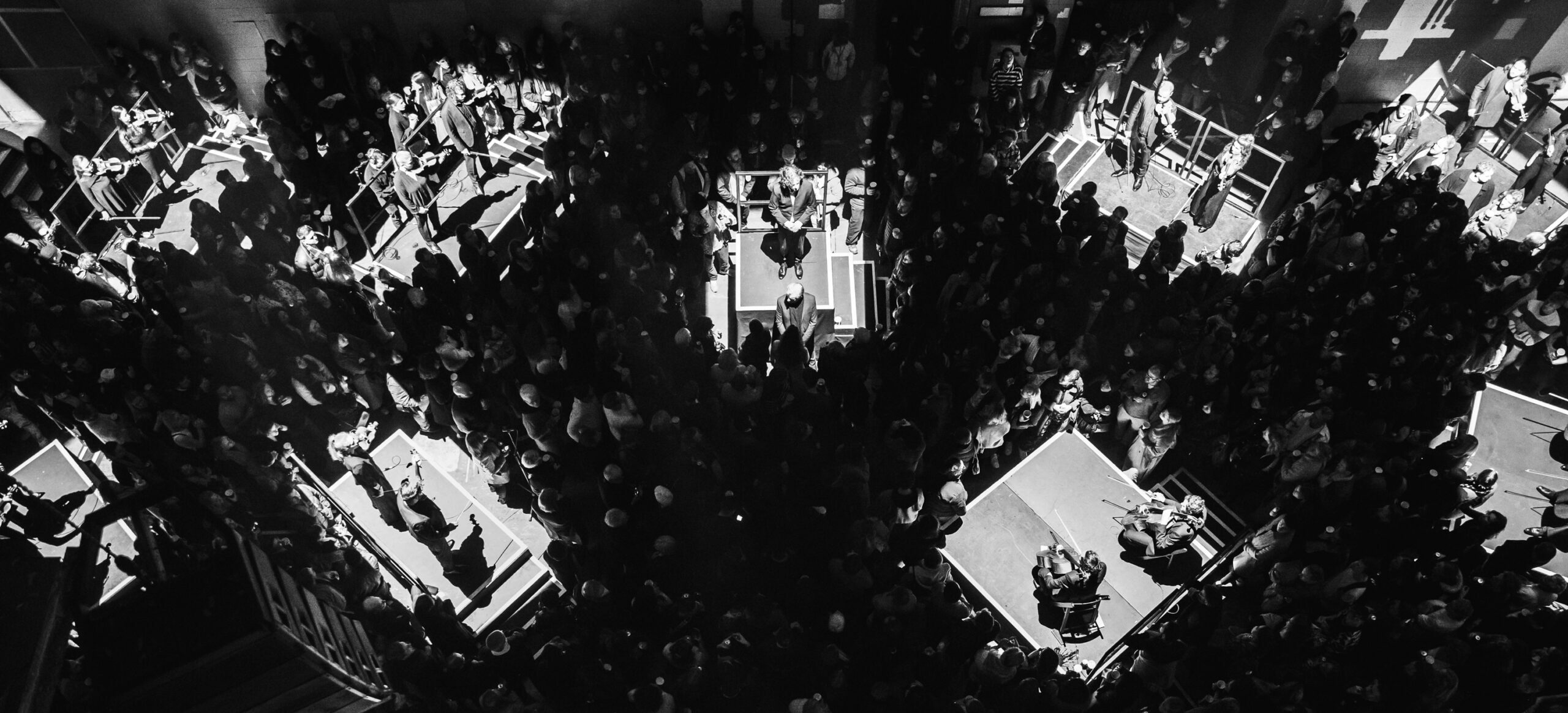
Where it began: memorised performance
In 2014, Aurora delivered a pioneering performance of Mozart’s 40th symphony at the BBC Proms: standing and playing without sheet music. What started as an eye-catching experiment has since developed into a core part of our concert output: over the past nine years, we’ve performed no fewer than 11 major classical works in this way, from Brahms’s First Symphony to, most recently, Stravinsky’s Rite of Spring.
For Principal Conductor Nicholas Collon and the Aurora players, there is huge musical appeal in working in this way: the memorising process requires a much longer rehearsal period than is ordinarily possible, and the shared depth of musical understanding achieved has meant that players often identify memorised projects amongst the musical highlights of their careers.
“having worked in such detail has made me understand the piece in a lot of depth and I will carry this for the rest of my life”
“Playing it from memory made space for so much more features of the music that are not written in the part. I felt able to express myself to a degree I don’t think I had before”
“the biggest team spirit I’ve ever seen in an orchestral project”
Player feedback, The Rite of Spring project
But we have also found that memorising unlocks other benefits. Take away music stands and the orchestra becomes uniquely versatile – the musicians can move, change formation, or even perform in the dark. Theatrical additions like design, costume and lighting can be used in new ways. We’ve found an orchestra performing by heart to be an incomparably powerful tool for musical explanation: musicians can move to show a musical idea, like a rhythm or a chord. In recent years we’ve loved exploring these many facets of memorised performance, all with the aim of helping audiences get under the skin of great music.
So we began to think: how could we go one step further? How could we use memorised performance to give an audience a totally new experience of classical music – by bringing them physically inside the piece being performed?
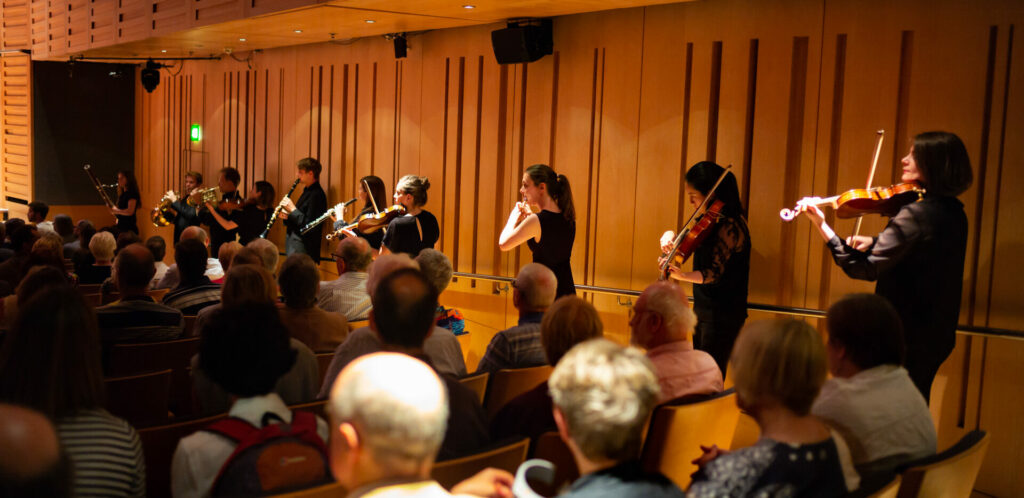
The immersive idea
Since our very first experiments in memorised performance back in 2014, we’ve explored immersive approaches in various intimate settings. Pop-up performances in shopping centres; schools’ workshops in which pupils wander among the orchestra; encores to memorised concerts, where members of the orchestra step off stage and out into the audience to play. Concert attendees often tell us that these moments are highlights for them – they love the sense of getting up close to players and being enfolded by the sound of the orchestra.
We often wondered if we could give this same sense of immediacy and connection to a larger audience for an entire performance of a symphony. We’ve also admired the work of several other groups both in the UK and internationally, who have in recent years undertaken their own adventures in immersive performance – Ivan Fischer’s Mittendrin concerts at the Berlin Konzerthaus, the Dutch ensemble Pynarello, and Southbank Sinfonia’s ConcertLab series to name a few. But bringing listeners inside an orchestra creates technical and musical challenges: as we’ve looked to expand an orchestra’s footprint, so we’ve found it also becomes harder to find a space which can accommodate the performance; to maintain precise ensemble across a large area; and to ensure that audience members throughout the space experience sound that is both balanced and thrilling.
Support from the RPS Audience Fund – in association with the Rachel Baker Memorial Charity – enabled us to take a major experimental step forward with this concept of orchestral immersion. In November 2021 and March 2023 we teamed up with Broadwick Live, Southbank Centre and audio specialists Southby Productions to deliver two immersive performances of symphonies by Beethoven (Nos. 7 and 5 respectively) at London’s iconic Printworks nightclub. By combining an orchestra playing from memory with cutting-edge digital sound reinforcement technology from d&B audiotechnik, the orchestra were able to perform ‘exploded’ across the floor of the Printworks Press Halls, interspersed with audience members, enabling listeners to get up close to the players in a way that would be impossible inside the concert hall.

To deliver these events we worked with Southby to install d&b’s most advanced technology system, Soundscape. Soundscape works by creating a ‘virtual acoustic shell’ consisting of many speakers positioned around the space. Each player of the orchestra is microphoned up, and their playing is fed through a complex algorithm that models the acoustics of a concert hall. This allows the orchestra to perform across a much larger space than would ordinarily be possible while retaining a naturally immersive sound. We worked with Southby to build what was one of the largest Soundscape installations ever created for these performances, with more than 70 speakers used to create the acoustic shell.
We also wanted to offer audiences a totally new experience of these iconic symphonies – relaxing the conventions of the concert hall and offering the chance to discover something new. For both projects, each movement of the symphony was ‘framed’ by new electronic music which has been inspired by Beethoven’s work, by Sam Swallow (November 2021) and Nwando Ebizie (March 2023 – co-commissioned with Southbank Centre).
Why attempt to do this?
Replicating the acoustics of a concert hall inside an enormous nightclub, and finding ways for Aurora’s musicians to play together while so spread out across the space, was very complicated and challenging. Why did we try to do it?
For audiences familiar with Beethoven, we wanted to provide a new kind of experience – a chance to hear new things in a well-known work, and to experience what it feels like to sit at the heart of an orchestra.
At Aurora, we also want to share the music we love with as many new people as possible. For this project we were especially keen to reach those who might not consider going to a ‘conventional’ Beethoven concert. We hoped the concept would particularly appeal to the growing audience for immersive events in unusual spaces – ‘experience-seekers’ who would be less interested in a traditional concert hall setting. We were also keen to attract listeners in the 25-34 age bracket who on average attend fewer classical concerts than older age groups (figures from The Audience Agency indicate that they account for just 6% of classical audiences in England).
How did it go?
Film by Stanton Media
We delivered four immersive performances at Printworks across November 2021 and March 2023. The November performances were each attended by 1,250 people; in March we increased this to 1,600.
We were thrilled to receive a wealth of positive feedback from audiences at both projects. The quotes below offer just a snapshot of the comments:
“What an extraordinary way to experience orchestral music”
“Amazing experience and really enjoyed the mixture of spaces that encouraged people to move around. It meant we got a variety of views and sounds.”
“I’ve been to a lot of classical concerts with standard setup and this was SUCH a better way to experience the music”
“The AV and supplemental work by Nwando made for a really amazing contrast to the traditional and interpreted sounds of the symphony.”
“Absolutely electric…if there’s a night to make you hopeful about the future of classical music, it was this”
“It was so refreshing and inspiring to see you embrace new and exciting methods of performing in order to bring this music to a young, and enthusiastic audience. The energy was incredible. Exactly the breath of fresh air classical music needs at the moment”
‘I felt like I lived in the music”
Audience feedback, Printworks
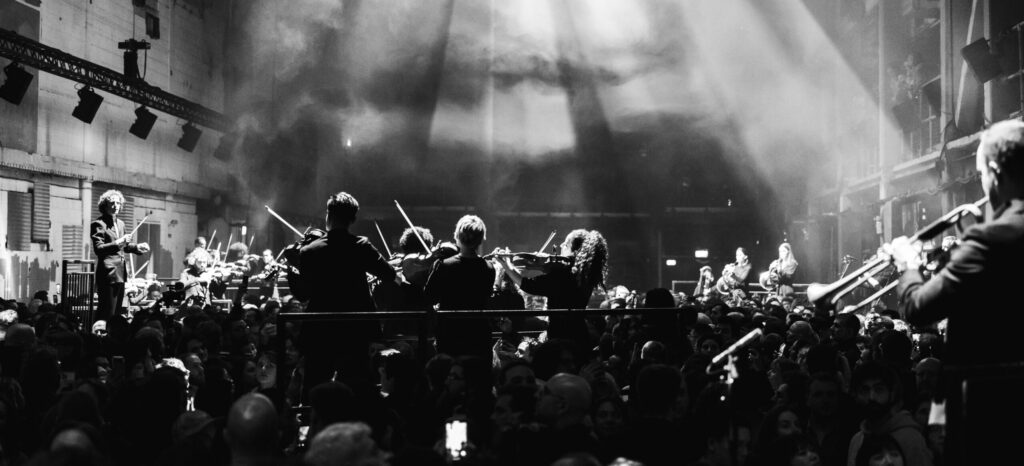
Audience breakdown
After each project, we worked with Printworks and Southbank Centre to build up a picture of who attended, including through running an audience survey. The results were very exciting for us: the core age bracket for both projects was 25-34, accounting for 46% of audiences in November 2021 and 48% of audiences in March 2023. For both projects, 83% of the audience was under the age of 45 (by way of comparison, research by the Audience Agency (2020) indicates that 88% of typical classical audiences in England are over the age of 45).
“I’m a typical Middle Aged classical music lover and I thought this would be different and fun. I’d never heard of Printworks. I loved it! I chatted to two women in their 20s who go clubbing at Printworks, and didn’t know anything about classical music…. But they also loved it! One said ‘I could feel the music in my body and it made me cry’. What more can you possibly ask for? Bravo!” – audience feedback, Printworks
In March, we sold just under half of the tickets to each performance through Southbank Centre. Although 60% of the bookers through Southbank Centre had seen Aurora performing before, we were able to introduce some of Southbank Centre’s audience to Printworks, and there clearly was an appetite for our regular audience to experience classical music in a new way: 93% of bookers in March 2023 were visiting Printworks for the first time.
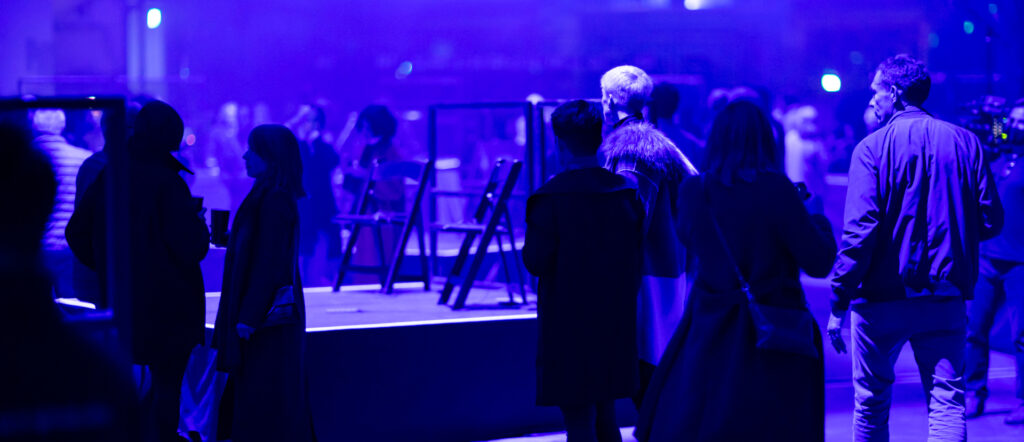
The challenges
Attempting to bring an audience physically inside a Beethoven symphony was undoubtedly a risk, and we were keen to receive constructive feedback from audience members and the Aurora players about their experience and how we can improve this experimental format for the future.
The artistic challenge to Aurora players was huge: performing spread out across a vast space, adjusting to the Soundscape technology, relying on sightlines rather than hearing, and being in such close proximity to enthusiastic audience members. The exploded set-up unsurprisingly created ensemble challenges, though these proved to be manageable thanks to the skill of both performer and technicians working on the two projects. We plan to continue refining the digital sound reinforcement technology and finding solutions to these ensemble challenges, so that we can deliver future immersive experiences with the best sound possible.
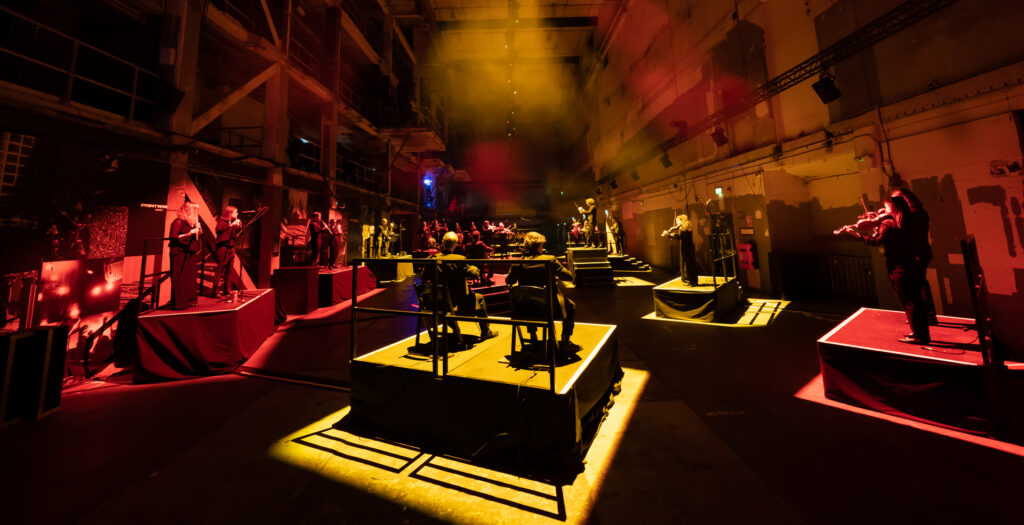
In March, we decided to try increasing audience capacity for the shows. Survey feedback indicated that this exceeded the limit of what was comfortable for some audience members; it also meant that some attendees felt less able to move around and explore the space and the orchestra between the movements of the symphony. We will certainly take this into consideration when planning future immersive projects and possible orchestral layouts; being able to move around and explore is an important part of the concept, and we want to ensure that this is possible whilst also creating the thrilling ‘nightclub’ atmosphere which made our first experimental events so exciting and distinctive.
Some audience members also expressed disappointment that the orchestra only played one symphony. For players, the challenge of memorising one symphony is huge, and given that the immersive set-up relies on memorisation, it would be very difficult to extend this to multiple pieces. However, we’re now looking at ways to extend the audience’s engagement with the single memorised work across a longer immersive experience.
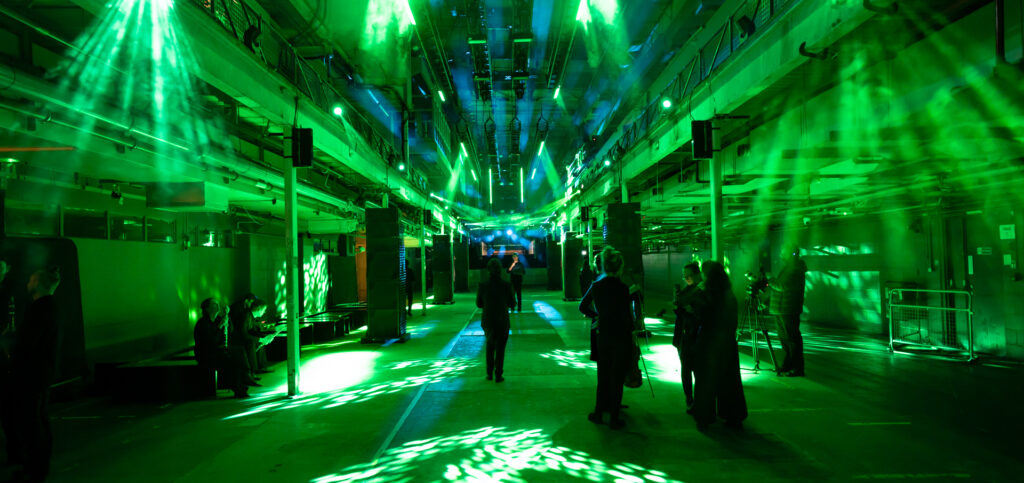
Summary
At Aurora, we love experimenting with concert formats in pursuit of the next orchestral adventure. We’re enormously grateful to the Royal Philharmonic Society’s Audience Fund and the Rachel Baker Memorial Charity for making this latest adventure possible – risk-taking projects like this can only become a reality with the support and trust of our generous funders and supporters. We’d also like to thank Arts Council England; Signatur, for their support of the November 2021 project; and Cockayne – Grants for the Arts and the London Community Foundation, for their support of the March 2023 project.
We’re also very grateful to our audiences in November 2021 and March 2023 for coming along for the ride with us, and helping us to shape future immersive projects by sharing their thoughts on the experience. Thank you!
What next? Based on our learnings from the two Printworks projects – including the things that didn’t go to plan – we’re now dreaming up ideas for future immersive experiences, including exploring some other extraordinary venues. Watch this space for further announcements…
